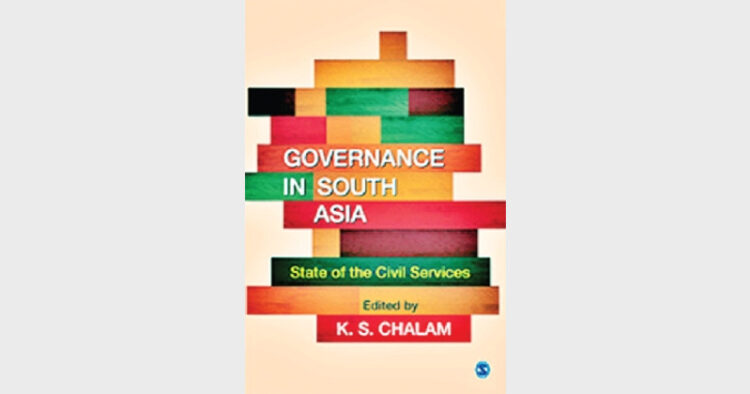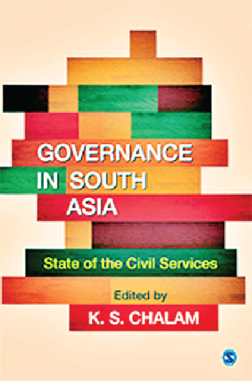Politics by Another Name
|
?Intro:Although the book has been enriched by renowned personalities yet they have confined themselves to the history, composition and the methodology of the Service Commissions. None of the contributors has gone into the strengths and weaknesses of the process by which the Members are appointed to these Commissions. The editor’s writing leaves a lot to be desired. In addition to incomprehensible sentences, there are factual inaccuracies in the book.
The title and the sub-title of the book Governance in South Asia: State of the Civil Services contain two apparently irreconcilable words with which every student of Public Administration has struggled. How can a system of administration “govern” and “serve” at the same time? Can one of these exist to the exclusion of the other? If not, which of these should dominate in the psyche of the administrator?
The title gives the book a huge canvas. The subtitle limits it. The truncation, however, leaves the political executive out of most of the discussions. The question whether Civil Services can be considered apart from the political government of the day merits discussion.
The geographical area covered by the book is very diverse; from Maldives with a population of a third of a million to India with its 1,250 million. Yet, we are all South Asians and as the book brings out, it is more than geography that binds our systems. The colonial past, racial affinities and a long history of trade between these countries have resulted in a deep unity in the apparent diversity of these countries.
The book has chapters contributed by many known figures including the editor KS Chalam and BhureLal, former Members of UPSC, MH Ansari, the Vice-President of India, N Vittal, Madhav Godbole and BK Chaturvedi Retired IAS officers, Justice Rana Bhagwandas, Chairman, Pakistan Public Service Commission and former Chief Justice of Pakistan, officers of Central Services and other renowned academics. The areas in focus are the Service Commissions and the well-beaten issue of corruption.
The contributors, however, confine themselves to the history, composition and the methodology of the Service Commissions. None of the contributors has gone into the strengths and weaknesses of the process by which the Members are appointed to these Commissions. The quality of the Civil Services is determined, to a large extent by the quality of the Commissions. The UPSC of India is a case in point. Suddenly, a name crops up and the next thing we hear is that the person has been appointed as a Member of the Commission. The process is not much different from the appointment of Governors and there is reason to believe that it is as tainted by political considerations. Irrespective of the fact that the selections by UPSC have been, in public eye, based on merit, the selection of Members of UPSC needs to be through a broader process of debate and discussions. The position in this regard is more or less the same in all the countries of South Asia.
An important role of UPSC, comprising promotions, not only among the Central Services but also for all Group A posts, including engineering posts in the Union Territories, has been left out. These Selection Committees are chaired by a Member of the UPSC and are a major contributor to the quality of senior bureaucracy in the country when they cull out deadwood or fail to do so. Similarly, the unusual provisions of permitting lateral entry to the IAS from teachers, doctors and other State employees have not been discussed. This issue, coupled with reservations and 33 per cent promotions from the State Civil Services, means that officers who come on their own merit after selection by the Commission are actually in a minority. The editor says that there are “very few studies to relate the performance of an officer and his academic achievements to confirm or reject meritocracy in Civil Service in India”. The outcome of these few studies, however, does not find place in the book.
Coming to the theme of corruption, which is the leitmotif of any discussion of Civil Service, and this book is no exception, the focus has been on narrating the malady. One expected something on the important issue of the relationship between corruption and economic growth. While some claim that there is an inverse relationship between the two, others cite the example of China where, in spite of rampant corruption, the country has witnessed a high growth rate and the corruption seems to have increased with economic growth. Similarly, in Japan, there were major cases of corruption during the period of very high growth.
Madhav Godbole has touched upon the theme of State regulation and its link with corruption. It is, however, seen that even the capitalist economies have large-scale interventions through subsidies and tariffs. There can be complete de-regulation only in anarchy. In India, there have been serious allegations that commodity shortages and high prices have been orchestrated through export policies relating to agricultural commodities, particularly onions, pulses and sugar. This is where the limitations of a civil servant’s capacity to intervene come into focus. We expected a discussion on the relationship between a Secretary and his Minister. Is the Secretary a mere subordinate to the Minister confined to an advisory role or does he have a duty coupled with a right to play an interventionist role when policies openly promote sectarian interests and are derogatory to wider public interest?
The editor’s writing leaves a lot to be desired. In addition to incomprehensible sentences, there are factual inaccuracies as when the editor says that the “State service officers are responsible for the functions listed in the State list of the Constitution” or when he opines “the salary and perks received by a group A officer is (sic) comparable if not better than corporate executives”. That can be said about group C and D employees. But the starting pay of about Rs. 30,000 per month of a group A officer is nowhere near that of a corporate executive.
Should a uniformed force like Police be considered as part of the Civil Service of a State as this book has done? The answer to this question would give legitimacy or otherwise to the recent trend of giving non-police functions to police officers. For example, in many States, police officers are heading the departments of sports, transport, housing etc. In one State, many years ago, a police officer was Chief Secretary, who then moved on to become Member, UPSC and then Governor of a State. That he was appointed to all these three posts in succession by the political executive of the day without any laid down criteria and that this is the practice in all our neighbouring countries shows adequately how Civil Service and governance, not only in India but also in entire South Asia, continue to be politics by another name.
R N Prasher ?(The reviewer is a retired IAS officer, 1975 batch)?



 Governance in South Asia: State of the Civil Services; Edited by KS Chalam ; Sage Publications; Pp 304, Rs 895. 00?
Governance in South Asia: State of the Civil Services; Edited by KS Chalam ; Sage Publications; Pp 304, Rs 895. 00?









Comments